While Kyoto is home to over a thousand Buddhist temples, one particular temple stands out from the rest— the iconic Kiyomizu-dera. Located in Kyoto’s eastern region, the temple is one of Ancient Kyoto’s 17 Historic Monuments. While the temple was founded in 773 AD, its present structures were constructed in 1663 through Tokugawa Iemitsu’s orders.
Kiyomizu-dera’s name means clean water or pure water— based on the waterfall within the temple grounds. Several shrines make up the temple complex, each of which is a setting for a variety of traditions and rituals. Interestingly, no single nail was used in its construction.
The temple was established after a Hosso Buddhist monk dreamed about a river of gold flowing from Mount Otowa. The legend goes that the monk met a god while in the mountains who then inspired him to build the temple. All the structures of the current temple were no longer the original. Throughout Kiyomizu-dera’s long history, it was razed to the ground by several fires. So, the current structures are a reconstruction of the original.
The temple’s scenery resembles the changing seasons
Kiyomizu-dera’s location was meticulously selected to effectively showcase the different sceneries reflecting the seasons. In springtime, the scenery is covered by cherry trees in bloom. Lush green covers the temple grounds in the summertime. Different-colored leaves stand out in falls. At Christmas time, the area looks picturesque covered in snow.
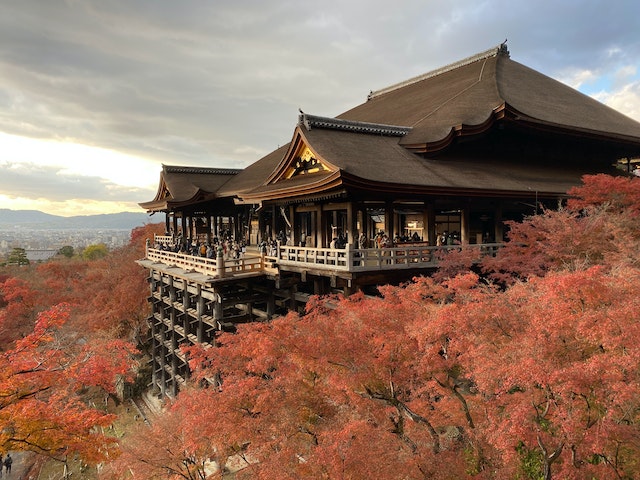
Interestingly, the peaks surrounding the temple offer varied viewpoints of the area surrounding the landscape as well as the city below. Depending on which part of the temple you are standing on or what time of the day it is, the panoramic view also shifts. What is striking, however, is how well the temple’s landscape harmonizes with the equally enchanting views of the ancient city below.
No nail was used in the complex’ construction
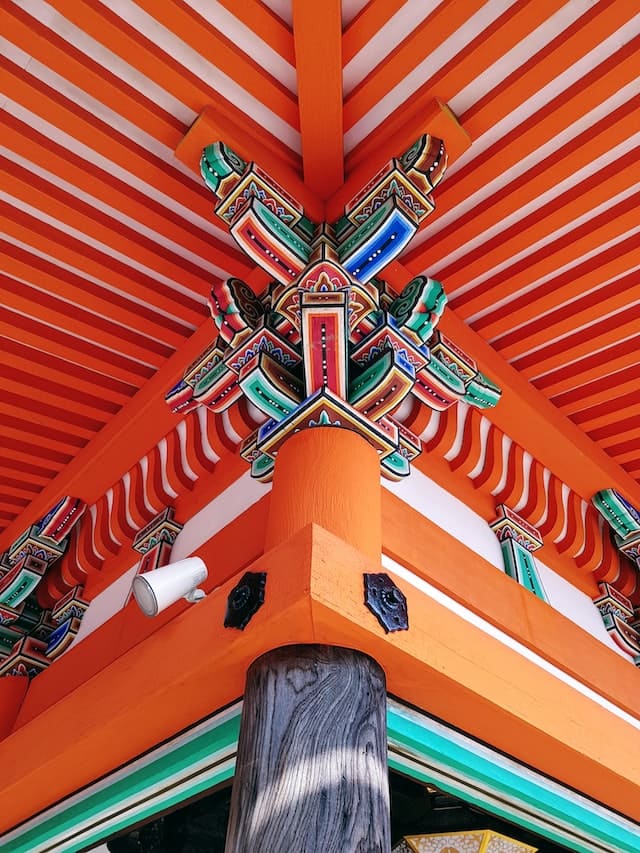
Built in 773, the temple is one of the country’s oldest. However, the construction of the entire complex was completed in 1663. What makes the whole construction feat remarkable is the fact that not a single nail was used for any of the structures in the complex. The reason for this is that, at the time, the prevailing architecture did not require the use of nails to hold structures in place.
The 13-meter verandah situated in the temple’s main hall is perhaps the highlight of the entire complex. Made up of 139 trees, the iconic platform was constructed following the same architectural concept of not using a nail to hold it in place. The “hell frame” method was used in the veranda’s construction. It’s even more impressive how the verandah has remained sturdy even though it had been around for about 400 years!
A Hosso Buddhist monk founded the temple
According to Kyoto region tradition, Kiyomizu-dera was established by a special Buddhist monk. A Hosso Buddhist monk named Enchin is credited for the temple’s founding. However, he was no longer around to witness the completion of Kiyomizu-dera’s construction. A noble warrior became the patron of the temple’s construction. Sakanoue no Tamuramaro played a huge part in the completion of the temple.
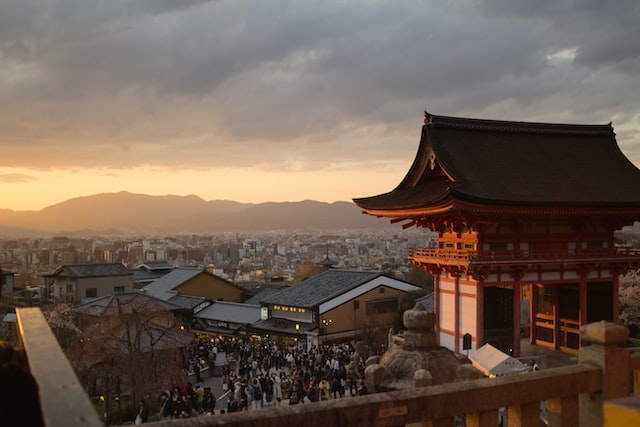
It was said that he was inspired by a god while he was in the mountains. Another story stated that he foresaw the construction of the temple in his dream. He had a vision of a river of gold flowing down from Mt Otowa. Over its long history, the temple has seen its fair share of reconstructions and renovations. Several fires led the structure to burn down, so the current structure is no longer the original construction. When the complex was reconstructed, however, the original architectural plan and models were still faithfully followed. So, the original structure has long been gone, what stands in its place today is pretty much an accurate representation of what it originally was.
Kiyomizu-dera opens its doors really early

It is common for Shinto shrines and Buddhist temples in the Kyoto area to open their doors to visitors at 9 am. Kiyomizu-dera on the other hand opens its doors pretty early. Opening to the public at 6 am, it is one of the temples in the Kyoto area that visitors can head out early to.
Interestingly, coming here at dawn has certain advantages! For one, you won’t have to deal with traffic jams at these very early hours of the morning. Since the temple is a popular tourist attraction, coming early means not having to jostle with the crowds. Even when you’re not staying close enough where you can walk to the temple, you can still get here before the gates open. JR Kyoto Station’s earliest bus service is at 5:33 am, which means you’ll be at the temple right when it opens!
A temple with many shrines
When Kiyomizu-dera was built, it was intended to be a temple on its own. However, within the temple complex are several other shrines to which people offer prayers to. For instance, there is the Jishu Shrine, dedicated to the god of good matches and love. It is most notable for its “love stones”. Located 10 meters apart, it is common practice for visitors to walk with eyes closed through the space between these stones.
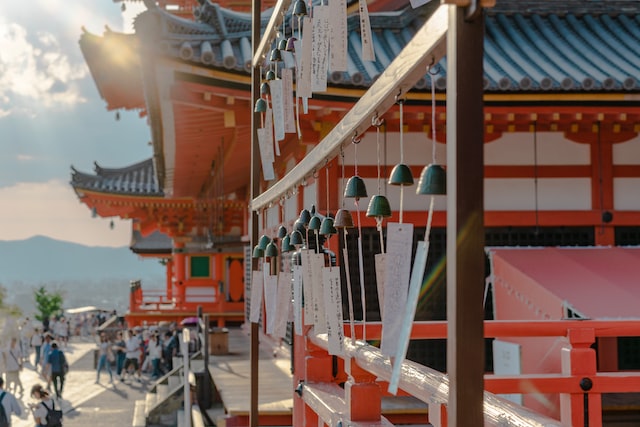
When Kiyomizu-dera was built, it was intended to be a temple on its own. However, within the temple complex are several other shrines to which people offer prayers to. For instance, there is the Jishu Shrine, dedicated to the god of good matches and love. It is most notable for its “love stones”. Located 10 meters apart, it is common practice for visitors to walk with eyes closed through the space between these stones.
It has long since been believed that people who successfully cross the stones with their eyes closed will fund their true love. If a person needed assistance in crossing, it signifies that a go-between is needed for them to find their love. A person’s romantic interest may also choose to assist them while crossing over.
A popular attraction
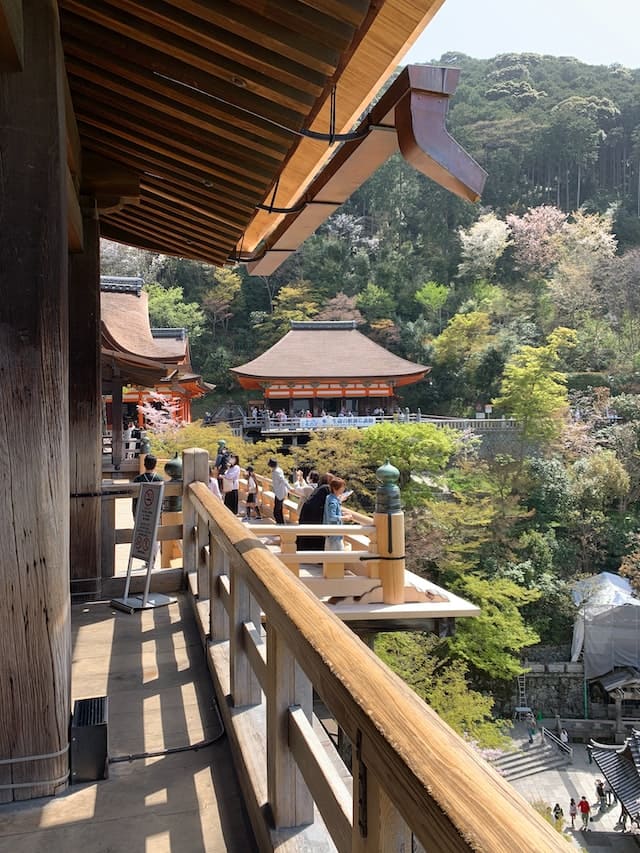
As one of the most celebrated temples in Japan, it is hardly surprising how popular an attraction Kiyomizu-dera is. People who are of the Buddhist faith and even those that are not religious or spiritual in the first place come to the temple pretty regularly. Every year, an average of 4.5 million people come to pay their respects to the temple. As foot traffic can be quite hectic, visitors are often advised to come to the temple early.
Many first-time visitors to Japan often have the temple at the top of their must-visit list. As one of the country’s most iconic and most photographed temples, this is hardly a surprise. It doesn’t hurt that no matter the season, a visit to the temple is always ideal. With the temple known for opening its doors earlier than the other temples in the area, getting here earlier is always advised.
Secret Buddha chamber
The temple has a secret Buddha chamber. The area is usually not open for the rest of the visiting public to check out. However, it is possible to arrange a tour inside this chamber. You do need to call ahead of time and book in advance. Since it is a revered part of the temple, photography is not allowed inside the chamber.
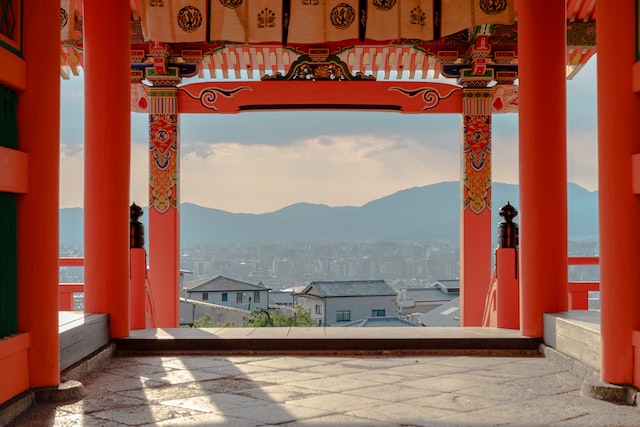
A total of 4,700 Buddha tiles are used to line the secret chamber. In addition, there are more than 1,000 small buddha statues made of stone inside the temple. These ancient statues were gathered from all over Japan and then brought to the temple.
A waterfall within the temple property

Kiyomizu-dera stands apart from the rest of other temples in the area mainly due to its impressive temple grounds. Beautiful to see no matter the time of the year or the season, it’s one of the many reasons the spot has always been popular among local and foreign visitors alike. Another thing that makes the temple unique is that it has a waterfall right beneath its main hall.
Known as Otowa Waterfall, it is where the temple got its name from. The fall provides clean water which is why Kiyomizu is known as the “pure water” temple. Otowa Waterfall is known for having three water channels that then drain into a pond. It is common for visitors who come to the temple to catch the water from the fall and drink it. Devotees believe that the water has powerful properties to grant them their wishes.
Impressive verandas within the shrine grounds
The overall design of the complex emphasizes accommodating as many people at one time. This is why among the most notable features of the temple are its large verandas. Supported by impressively tall pillars, these verandas serve as a wonderful viewing deck for visitors to the temple. Jutting out from the hillside, they provide the perfect spot for those that want to get a good view of the cityscape below.
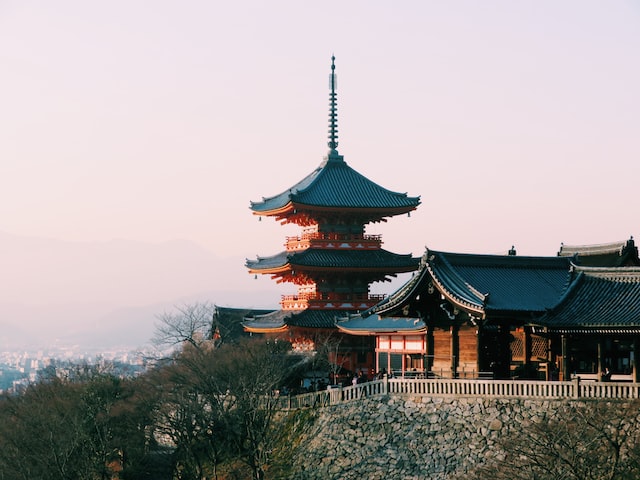
When the temple was constructed during the Edo period, the concept behind the large verandas remains the same— to accommodate as many pilgrims as possible. The temple grounds are also known for its impressive number of cherry and maple trees. With over 1500 cherry trees, the temple ground is a sight to behold in spring when the trees go bloom. With around 1,000 maple trees within the property, fall is also a spectacular sight here as the leaves turn into wonderful hues of yellow, orange, and red.
A strange tradition
Back in the day, there is a strange yet popular tradition that devotees who come to the temple used to do. In the Edo period, there was an expression about “jumping off of Kiyomizu’s stage” which was taken quite literally by some risk-taking Japanese. Many interpreted this as taking the plunge which led to over 200 people jumping off the terrace connected to the temple. There seemed to be a prevailing belief at the time that surviving the jump would make their wish come true. Only 80% of those that did jump off survived.

Needless to say, the practice for banned. So, you can rest assured that there won’t be stunts of random tourists randomly plummeting from the temple’s terrace. The spot, however, is the perfect setting to get a view of the dramatic cityscape of Kyoto below. There is a reason why it is one of the most photographed parts of the temple, after all.
Aside from its magnificent views, Kiyomizu-dera has long since been known for its “power spots”. Dedicated to the deities of longevity and love, people who are hoping to finally find their true love often come here to offer their respects. Even those who are about to take on important exams come to the temple to pray. It is believed that its power spots can help boost one’s test scores.
An iconic part of Kyoto
Along with Kinkakuji, Kiyomizu Temple is one of the first things that come to mind if one were to think of Kyoto. This is hardly surprising as it is an icon synonymous with Kyoto’s impressive status as a center for Japanese culture, history, and religion. It is also a wonderful reminder of the city’s glory days when it used to be hailed as the country’s capital. With its long history, cultural significance, impressive architecture, and wide renown, Kiyomizu-dera is a good enough reason to visit Japan and visit Kyoto.
